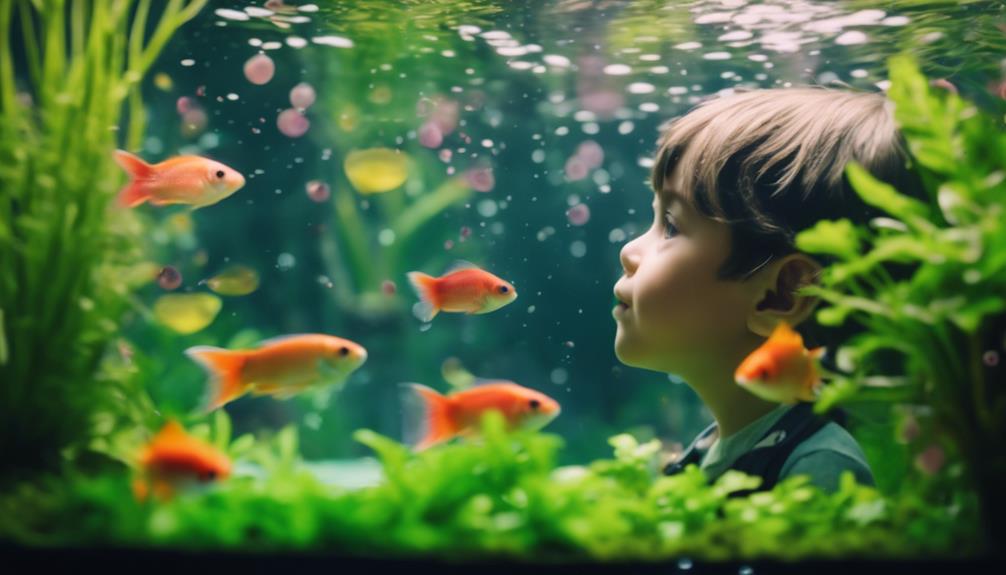Friendly Fishkeeping: Pet Fish Care Tips

Pet Fish Care Tips: When it comes to caring for your aquatic companions, think of your fish tank as their high-rise apartment building – it needs to meet all their needs to thrive. But, ensuring a harmonious underwater world involves more than just filling the tank with water and fish. From the size of the tank to water quality essentials, each aspect plays a crucial role in the well-being of your fish. So, let’s dive deeper into the world of friendly fishkeeping and explore some essential tips for keeping your pet fish happy and healthy.
Tank Size Matters
When considering the well-being of your pet fish, the significance of tank size cannot be overstated. A properly sized tank is essential for creating a healthy and thriving environment for your aquatic friends. Not only does the tank size impact the overall well-being of your fish, but it also plays a crucial role in influencing their behavior and interactions within the tank.
Fish behavior is heavily influenced by the size of their tank. In smaller tanks, fish may exhibit signs of stress, and aggression, or even become territorial due to the limited space. On the other hand, in a larger tank, fish have more room to swim freely, explore their surroundings, and exhibit their natural behaviors. Providing adequate space through a properly sized tank can help reduce stress levels and promote a harmonious environment for your fish.
Additionally, the size of the tank also allows for proper tank decoration placement. A larger tank provides more surface area for placing decorations such as plants, rocks, and hiding spots, which can mimic a fish’s natural habitat. Creating a well-decorated tank not only enhances the aesthetic appeal but also provides enrichment for your fish, allowing them to engage in natural behaviors like exploring, hiding, and playing.
Water Quality Essentials
Maintaining your filter is crucial for keeping your fish healthy, as it helps remove waste and debris from the water. Regularly testing water parameters like pH, ammonia, and nitrate levels ensures a safe environment for your aquatic pets. Changing a portion of the water on a consistent schedule helps dilute harmful substances and keeps your fish thriving.
Filter Maintenance Importance
Regularly cleaning and maintaining your aquarium filter is essential for ensuring optimal water quality for your pet fish’s health and well-being. Proper filter maintenance involves selecting the right filter media and ensuring it is regularly cleaned or replaced to prevent harmful substances from accumulating in the water. Preventing filter malfunctions is crucial to maintain a stable aquatic environment for your fish. Here are some key tips for effective filter maintenance:
- Choose the appropriate filter media based on your tank setup.
- Clean or replace filter media according to the manufacturer’s recommendations.
- Rinse mechanical filter media in tank water to preserve beneficial bacteria.
- Check for clogs or blockages in the filter system regularly.
- Monitor the filter’s flow rate to ensure proper function.
Testing Water Parameters
Ensuring the water quality of your aquarium through regular testing of key parameters is crucial for the health and well-being of your pet fish. Water testing techniques are essential to maintain a balanced aquatic environment. Test kits are readily available and easy to use, allowing you to monitor levels of ammonia, nitrites, nitrates, pH, and temperature.
Proper result interpretation is vital; for instance, high ammonia or nitrite levels can be toxic to fish. If you encounter issues like high ammonia, performing partial water changes and reducing feeding can help. Troubleshooting water parameter problems promptly is crucial. Solutions may include adjusting filtration, increasing aeration, or adding beneficial bacteria to establish a healthy biological balance. Regular testing and quick action ensure a thriving aquarium ecosystem.
Changing Water Regularly
To maintain optimal water quality for your pet fish, it is essential to prioritize changing the water regularly as a fundamental aspect of aquarium care. Regular water changes help remove accumulated waste and replenish essential minerals for your fish’s well-being. Here are some tips to make water changes a breeze:
- Perform weekly water changes of about 10-20% of the tank volume.
- Use a siphon to vacuum the substrate during water changes to remove debris.
- Treat new water with a dechlorinator to neutralize harmful chemicals.
- Monitor water temperature and match it closely to the tank water before adding.
- Avoid overcleaning to maintain beneficial bacteria presence for a healthy aquarium ecosystem.
Proper Temperature Control
Maintaining optimal water temperature is crucial for the health and well-being of your pet fish. Sudden temperature fluctuations can stress your fish, compromising their immune system and making them more susceptible to diseases. To prevent this, invest in a reliable aquarium heater and thermometer to monitor and regulate the water temperature consistently.
Heater malfunctions can be a nightmare for fish owners. In the case of your heater failing, your quick response is vital. First, unplug the malfunctioning heater to prevent any further temperature spikes. Next, gradually lower the heater’s temperature setting to prevent a sudden drop in water temperature that could shock your fish. Consider having a backup heater on hand for emergencies to maintain a stable environment for your aquatic friends.
Decorate With Care
When decorating your fish tank, consider the needs and safety of your aquatic pets as a top priority. Creating a visually appealing aquascape design while ensuring you choose fish-safe decorations is crucial for the well-being of your finned friends.
- Aquascape Design: Plan your aquarium layout carefully, considering the natural habitats of your fish species. Incorporate plants, rocks, and driftwood to mimic their native environments.
- Choose Fish Safe Decorations: Opt for smooth decorations without sharp edges that could injure your fish. Avoid decorations with small parts that fish could swallow and choke on.
- Natural Elements: Integrate live plants to not only enhance the aesthetics but also provide oxygen and improve water quality for your fish.
- Avoid Toxic Materials: Be cautious with decorations that may contain harmful substances like lead or copper, as they can leach into the water and poison your fish.
- Consider Fish Behavior: Tailor your decorations to suit the behavior of your fish. Provide hiding spots for shy species and open spaces for active swimmers.
Lighting Requirements
Consider the importance of proper lighting to support the health and vitality of your pet fish. Lighting plays a crucial role in replicating the natural habitat of your fish, ensuring they thrive in a comfortable environment. When setting up your aquarium, think about the lighting schedule you will provide. Just like in the wild, fish need a consistent day and night cycle to regulate their internal clocks and behaviors. Additionally, if you have aquatic plants in your tank, they will require a specific amount of light to undergo photosynthesis and grow effectively.
To meet these requirements, explore LED options for your aquarium lighting. LEDs are energy-efficient, long-lasting, and provide a full spectrum of light that mimics natural sunlight. This type of lighting not only benefits your fish but also enhances the colors of your aquatic plants, creating a visually appealing underwater landscape.
When choosing the right lighting for your aquarium, consider the specific needs of your fish species and plants. Research their natural habitat to understand the intensity and duration of light they require. By investing in quality LED lighting and establishing a suitable lighting schedule, you can create a thriving ecosystem that promotes the well-being of your pet fish and aquatic flora.
Filtration Systems
When it comes to keeping your beloved fish healthy and happy, understanding filtration systems is key. Different filter types serve distinct purposes in maintaining water quality, from mechanical to biological filtration. Regular maintenance is crucial to ensure your filter operates efficiently, safeguarding your aquatic friends’ well-being. Remember, cycling your tank is not just a one-time task; it’s an ongoing process that establishes a healthy environment for your fish to thrive.
Filter Types Explained
Understanding the different types of filters for your aquarium is crucial for maintaining a healthy and thriving aquatic environment for your pet fish. When choosing a filter, consider the media types it uses and the benefits they offer, such as mechanical, biological, and chemical filtration. The flow rate of the filter is also essential as it determines how quickly water passes through the filtration system, impacting the efficiency of waste removal and oxygenation. Here are five key points to help you grasp filter types better:
- Internal Filters: Suitable for small tanks.
- Canister Filters: Ideal for larger tanks.
- Hang-On-Back Filters: Easy to install and maintain.
- Sponge Filters: Great for fry and shrimp tanks.
- Undergravel Filters: Provide biological filtration.
Maintenance Frequency Tips
To maintain the optimal performance of your filtration system and ensure the well-being of your pet fish, adhering to a regular maintenance schedule is essential. Cleaning techniques play a crucial role in keeping your filter running efficiently. Regularly rinse mechanical media in tank water to remove debris. For biological media, gently swish in tank water to dislodge dirt without disrupting the beneficial bacteria.
Algae control is vital too. Wipe down the exterior of your filter to prevent algae buildup, which can affect its function. Additionally, monitor water quality by testing for ammonia levels. High ammonia can harm your fish, so test regularly and perform water changes as needed to maintain a healthy environment. By staying on top of maintenance, you ensure a thriving aquatic ecosystem for your beloved fish.
Importance of Cycling
Proper cycling of your filtration system is a fundamental cornerstone in maintaining a healthy and thriving aquatic environment for your pet fish. Cycling benefits your aquarium by establishing a stable nitrogen cycle, crucial for fish health. Misconceptions about cycling can lead to harmful ammonia spikes, stressing your fish. To ensure successful cycling, use a reliable water test kit to monitor ammonia, nitrite, and nitrate levels. Avoid common mistakes like adding too many fish at once, which can overwhelm the system. Troubleshooting tips include partial water changes to reduce ammonia levels and adding beneficial bacteria supplements to kick-start the cycling process. Remember, a well-cycled tank provides a stable environment for your fish to flourish.
- Establishing a stable nitrogen cycle is key.
- Monitor ammonia, nitrite, and nitrate levels with a water test kit.
- Avoid adding too many fish at once.
- Perform partial water changes to reduce ammonia.
- Consider using beneficial bacteria supplements.
Feeding Your Fish
When caring for your fish, ensure you provide them with a balanced and nutritious diet to support their health and vitality. Establishing a proper feeding schedule is crucial. Different fish species have varying dietary requirements, so research what is best for your specific fish. It’s important to maintain a nutritional balance in their diet to keep them healthy and happy.
Offer your fish a variety of foods to ensure they receive all the necessary nutrients. Pellets, flakes, frozen, and live foods can all be part of their diet. Remember to control the portions you feed them. Overfeeding can lead to health issues and water quality problems in your tank. Fish are opportunistic feeders, so they will often eat more than they need if given the chance.
Feed your fish small amounts 2-3 times a day, depending on the species. Observing their eating habits can help you determine the right portion sizes. Uneaten food should be removed promptly to prevent it from decomposing and affecting the water quality. Providing a balanced diet with proper portion control will help your fish thrive and contribute to a healthy aquatic environment in your tank.
Avoid Overfeeding
You must resist the urge to overfeed your fish. Overfeeding can lead to various health issues, such as obesity and poor water quality. Pay attention to your fish’s behavior and adjust their feeding schedule accordingly to ensure their well-being.
Proper Feeding Frequency
For optimal health and vitality of your pet fish, it is crucial to maintain a balanced feeding schedule to prevent overfeeding. Proper feeding frequency is key to ensuring your fish receives the right nutrients without causing harm. Here are some tips to help you get it right:
- Feeding Schedule Optimization: Establish a consistent feeding routine.
- Fish Nutrition Guidelines: Ensure your fish receive a balanced diet.
- Portion Control: Feed your fish an amount they can consume in a few minutes.
- Dietary Diversity: Offer a variety of foods to meet their nutritional needs.
- Monitor Fish Behavior: Watch how your fish react to feeding to adjust accordingly.
Monitoring Fish Behavior
To prevent overfeeding and ensure the well-being of your pet fish, observe their behavior closely during feeding times. By paying attention to behavioral observation techniques, you can gauge if your fish are receiving the right amount of food. Overfeeding can lead to health issues and water quality problems. Watch out for fish stress signals like excessive hiding, erratic swimming, or lack of appetite. Implement behavioral enrichment ideas such as providing diverse feeding methods or introducing tank decorations for mental stimulation. If you notice fish aggression, consider adjusting the tank layout to create separate territories or adding more hiding spots. Monitoring your fish’s behavior not only prevents overfeeding but also promotes a harmonious and healthy aquatic environment.
Regular Water Changes
Regularly changing the water in your fish tank is crucial for maintaining a healthy environment for your aquatic pets. Clean water is essential for your fish’s well-being, as it helps to remove waste, excess food, and other pollutants that can harm them. Here are some tips to help you with your regular water changes:
- Frequency: Aim to change 10-15% of the water in your tank every week to keep it clean and healthy.
- Dechlorinate: Always treat new water with a dechlorinator to remove harmful chemicals before adding it to the tank.
- Siphon Gravel: Use a gravel siphon to clean the substrate during water changes, removing debris and waste that can accumulate.
- Check Temperature: Make sure the temperature of the new water matches the existing tank water to avoid shocking your fish.
- Observe Behavior: Monitor your fish after water changes; any sudden changes in behavior could indicate stress due to water parameters.
Maintaining water quality is crucial for the health of your fish. By keeping up with regular water changes, you create a clean and balanced environment that promotes the well-being of your aquatic friends. Remember, a little effort in water changes can go a long way in ensuring a thriving aquarium ecosystem.
Monitoring Water Parameters
Maintaining a healthy aquarium environment extends beyond regular water changes; closely monitoring water parameters is essential for ensuring your fish thrive. Water quality monitoring is crucial for the well-being of your aquatic pets. Keep a close eye on the temperature of the water, as different fish species have specific temperature requirements. Sudden fluctuations can stress your fish and weaken their immune systems, making them more susceptible to diseases. Invest in a reliable thermometer to accurately monitor the water temperature and ensure it stays within the optimal range for your fish.
In addition to temperature regulation, pH balance plays a significant role in the health of your fish. Fluctuations in pH levels can cause stress to your fish and impact their ability to breathe properly. Regularly test the pH of your aquarium water using a liquid test kit to ensure it remains stable within the recommended range for your specific fish species.
Another critical parameter to monitor is ammonia levels. Ammonia is highly toxic to fish and can quickly lead to illness or even death if not detected and addressed promptly. Use ammonia test kits to regularly check the levels in your aquarium and take immediate action if any ammonia is detected. By staying on top of water quality monitoring, you can create a safe and healthy environment for your beloved fish to thrive.
Tank Mate Compatibility
Ensuring harmonious tank mate compatibility is crucial for fostering a thriving aquarium ecosystem for your fish. Selecting the right tank mates for your fish involves understanding fish compatibility and species aggression, as well as considering social behavior. Here are five essential tips to help you create a harmonious community within your aquarium:
- Research Fish Species: Before adding new fish to your tank, research their specific requirements, preferred water conditions, and compatibility with other species.
- Consider Aggression Levels: Some fish species are naturally aggressive, while others are more peaceful. Avoid mixing aggressive species with timid ones to prevent bullying and stress.
- Tank Size Matters: Larger tanks provide more space for fish to establish territories and reduce territorial aggression. Ensure your tank is adequately sized for the species you plan to keep.
- Introduce Fish Gradually: When adding new fish to your aquarium, introduce them slowly to prevent territorial disputes and aggression. Monitor their behavior closely during the acclimation process.
- Observe Social Interactions: Watch how your fish interact with each other. Signs of aggression include fin nipping, chasing, and hiding. If aggression persists, consider rehoming the problematic fish to maintain harmony in the tank.
Handling Stressful Situations
When your fish face stressful situations, it’s crucial to maintain a calming tank environment to help them feel secure. Remember to handle your fish gently during these times to reduce their stress levels. Quick problem resolution is key to ensuring your fish’s well-being and happiness.
Calming Tank Environment
Creating a harmonious environment in your fish tank is essential for promoting relaxation and reducing stress in your aquatic pets. To ensure your fish are living in a serene and peaceful tank environment, follow these tips:
- Maintain Proper Water Quality: Regularly test and monitor water parameters to keep it clean and healthy.
- Provide Hiding Places: Incorporate plants, caves, and decorations to give your fish places to retreat when feeling stressed.
- Control Lighting: Ensure your tank has a suitable light cycle to mimic natural day and night patterns.
- Avoid Sudden Noises: Place your tank in a quiet area to prevent sudden loud noises from startling your fish.
- Introduce Tank Mates Carefully: Select compatible fish species and gradually introduce them to prevent aggression and stress.
Creating a calming tank environment is crucial for managing stress levels and promoting the well-being of your beloved aquatic pets.
Gentle Fish Handling
Maintaining a calm and steady demeanor when handling your fish during stressful situations is crucial for ensuring their well-being and reducing any potential harm. When introducing new fish to your tank, it’s essential to follow a gradual fish acclimation process to help them adjust to their new environment smoothly.
Slowly introduce them to the tank water by floating the bag in the tank to equalize the temperature before releasing them. When performing tank maintenance or cleaning, opt for gentle cleaning techniques to avoid stressing your fish. Use soft brushes or sponges to clean tank surfaces, and be cautious not to startle your fish with sudden movements. By handling your fish with care and consideration, you can help them thrive in a peaceful and safe environment.
Quick Problem Resolution
To swiftly address stressful situations in caring for your pet fish, employ proactive problem-solving strategies to mitigate potential harm and maintain their well-being. When facing issues, quick diagnosis techniques and rapid response strategies are key. Here are some troubleshooting tips to help you navigate emergency care solutions:
- Observe Behavior: Monitor changes in swimming patterns or appetite.
- Check Water Parameters: Test for ammonia, nitrites, and nitrates.
- Adjust Temperature: Ensure the water temperature is suitable for your fish.
- Perform Partial Water Change: Refresh the water to improve quality.
- Consult a Vet: Seek professional advice if problems persist.
Disease Prevention Tips
Ensure a clean and well-maintained aquarium to help prevent diseases in your beloved pet fish. Implement a strict quarantine protocol for any new fish before introducing them to the main tank. This step can prevent the spread of potential diseases that newcomers might carry. Quarantine tanks should mimic the main tank’s conditions to acclimate the new fish properly while allowing you to observe them for any signs of illness. If you notice any symptoms during this period, promptly start disease treatment to avoid further complications.
Preventative measures play a crucial role in maintaining a healthy habitat for your fish. Regularly test the water parameters such as pH, ammonia, nitrite, and nitrate levels to ensure they are within the optimal range. Sudden fluctuations in these parameters can stress your fish, making them more susceptible to diseases. Adequate filtration and regular water changes are essential to keep the water clean and free from harmful substances that can compromise your fish’s immune system.
Additionally, maintain a balanced diet for your fish to boost their immune system and overall health. Overfeeding can lead to uneaten food decomposing in the water, creating a breeding ground for harmful bacteria. By following these disease prevention tips and providing a nurturing environment, you can enjoy a vibrant and disease-free aquatic community.
Breeding Considerations
To successfully navigate the realm of breeding considerations for your pet fish, it is essential to understand the intricacies and responsibilities involved in fostering new life within your aquatic community. Breeding techniques play a crucial role in the successful reproduction of your fish. Understanding the mating behavior of your specific fish species is key to creating the right conditions for breeding success. Reproduction challenges may arise, such as aggressive behavior between mating pairs or difficulty in finding suitable mates. Properly caring for the fry that hatch is a delicate process that requires attention to detail and a nurturing touch.
Breeding Considerations:
- Research Your Fish Species: Understand the specific breeding habits and requirements of your fish.
- Create the Right Environment: Ensure your aquarium setup supports breeding behaviors and provides a safe space for fry.
- Monitor Mating Behavior: Watch for signs of courtship and spawning activities among your fish.
- Prepare for Reproduction Challenges: Be ready to address any aggression or compatibility issues that may arise during breeding.
- Care for the Fry: Provide appropriate food, shelter, and water conditions to support the growth and development of the young fish.
Consulting a Fish Vet
Considering the well-being of your aquatic companions, consulting a fish vet can provide invaluable expertise and guidance in ensuring the health and happiness of your pet fish. Fish, like any other pets, can sometimes exhibit unusual behaviors that may indicate underlying health issues. A fish vet can help you understand these behaviors and provide tailored advice on how to address them effectively.
When it comes to aquarium setups, a fish vet can offer recommendations on creating an optimal environment for your fish. They can advise on aspects such as water quality, temperature, filtration, and tank size to ensure that your fish have a comfortable and thriving habitat. Proper aquarium setup plays a crucial role in the overall well-being of your fish, and a fish vet can help you make informed decisions to promote a healthy ecosystem.
Moreover, regular check-ups with a fish vet can help prevent potential health problems before they escalate. They can conduct thorough examinations to detect any early signs of illness and provide proactive treatment to keep your fish in top condition. By consulting a fish vet, you show your dedication to providing the best care for your finned friends and enhance your knowledge of fish health and maintenance.
Pet Fish Care Tips Frequently Asked Questions
Can I Keep Different Species of Fish Together in the Same Tank?
You can keep different species of fish together in the same tank, but it’s crucial to consider species compatibility for harmonious tank mates. Watch out for aggressive behavior when setting up a community tank to ensure a peaceful coexistence.
How Often Should I Clean My Fish Tank and What Is the Best Way to Do It?
To keep your fish healthy, clean your tank every 2 weeks. Use a siphon to remove debris and change 10-15% of the water. Test water parameters regularly and control algae by reducing light and avoiding overfeeding.
What Do I Do if My Fish Is Showing Signs of Illness?
If your fish is showing signs of illness, it’s crucial to act fast. Start by quarantining the affected fish to prevent spreading. Research common diseases, assess symptoms, and consult a fish veterinarian for proper diagnosis and treatment options.
Are There Any Specific Plants or Decorations That Are Harmful to Pet Fish?
When setting up your aquarium, avoid toxic plants and decorations that could harm your pet fish. Choose safe tank accessories to promote fish health. Research and consult with experts to create a beautiful and fish-friendly environment.
How Can I Tell if My Fish Are Stressed and What Can I Do to Help Them?
If your fish seem stressed, watch for behavior changes like darting or hiding. Provide a calm environment by adjusting lighting and water conditions. Add plants and hiding spots. Gentle water changes and a consistent feeding routine can help relax them.
Conclusion
In conclusion, maintaining a healthy and happy aquarium for your pet fish requires dedication and attention to detail. By ensuring the right tank size, water quality, temperature control, and decorations, you can create a thriving environment for your finned friends. Remember to handle stressful situations with care, prevent diseases, and consider breeding options. And don’t forget, consulting a fish vet can provide valuable guidance for the overall well-being of your beloved aquatic companions. Happy fishkeeping!








